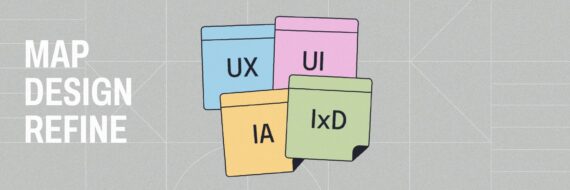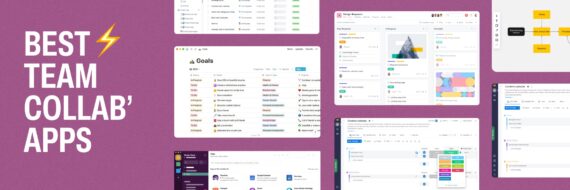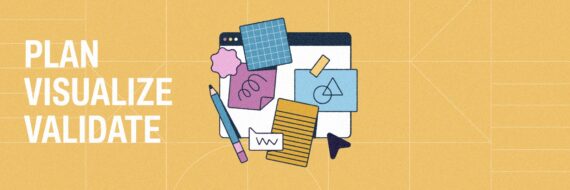So you’re new to the field of UX and realize you’re going to need to start putting together a portfolio. That’s what all the greats are saying, right? But now you’re questioning how to create a UX portfolio without UX experience? Well, you’ll be pleased to know that it’s easier than you think for anybody at any level to do this. It just takes a bit of a perspective shift. Portfolios are made of any UX work you’ve done, even the theoretical businesses and sites you dreamt up in your mind. Finally, all of that daydreaming your teachers got on you about is about to pay off.
What is a UX portfolio?
In short, a UX portfolio is comprised of the work you’ve done in UX design that you want people to see, with potential employers topping the list. Your résumé/CV is very likely the least of their concern; the résumé bots that employers run it through care more — but that’s a whole different topic. The computer or the six seconds the hiring manager eyed your résumé got you to the point of them looking at a portfolio, so this is your time to show off what you’ve done related to the job. It’s going to contain your best work in UX case studies, your design skills, insight into your design decisions which explain and justify your design process, what special skills you have and how you use them, lo-hi wireframes and a lot more. This is your calling card and not the time to give humblebragging a try. Time to get out there and honk your own horn; nobody else is going to do it for you.
Why a UX design portfolio is necessary
User experience is a very visual field, so without a portfolio in the visual design industry, what’s left? Stumbling over your words to describe that cool project you did for some snack manufacturer last year? Yeah, no. Recruiters want to see your work. They want results. Your process. Your work experience. They want to know how you have the know-how to create a final product that works. The “About Me” section on a UX designer resume with a cover letter doesn’t deliver that kind of “wow.”
🎬 Learn what Slickplan can do!
We filmed a short video to show you exactly how to use Slickplan
What to include in a UX portfolio
So what should be in a UX portfolio? Your UX design portfolio should showcase everything in your process in addition to the results. Examples include case studies, prototypes, research, style guides — anything used in the making. Write out a list of things to easily create a consistent portfolio across the board.
Consistency is key, so the purpose of writing everything out is two-fold; making sure you include everything you truly want to use and giving yourself direction on how to arrange things in the same format for each example. It just makes it easier to digest.
Along with everything listed below, your portfolio may include information about how you overcame certain difficulties in the process and even situations that went completely wrong and what you did to make it right. A word to the wise: don’t skip this because they’re probably going to ask anyway.
Here’s how to create a UX portfolio from scratch

1. Reading is fundamental
Whether it’s a degree or you’re self-taught through programs online like Udemy or Coursera, it’s a necessary step to getting what you want out of a career in UX design. Additionally, it’s highly advisable to keep up with what’s new. A senior UX designer doesn’t stay senior by idly sitting by. Keep up with the classes, not the Kardashians. There are a ton of free or very heavily discounted courses out there. Your UX research will need to continue for as long as you’re part of the industry.
2. Get the creative juices flowing
The start of any UX portfolio is pretty simple. You need to get some ideas out and into the real world. You can claim how you went to [insert school name here] ‘til the cows come home, but without the goods to back it up, it doesn’t matter. We’ve mentioned this is a very visual field. So get visual. This can be through smaller jobs people give you, personal creations, talking to local businesses, creating your own fake businesses and projects in your mind, or literally asking your mom’s book club. Seriously. Anything to get design work down and in the books. If you have no work, you have no portfolio.
3. Presentation is everything
Creating a portfolio has many options. First, decide if you’d like to use apps to display your work (Dribble, Behance, Adobe Portfolio, etc.) or if creating a website is your better option instead. This is going to be a critical decision. What are you comfortable with? What makes the most sense to you? What will be the best option for you to present most seamlessly? We’ll go over these options a bit more later in this article. Keep in mind all of the options because UX professionals like to see fully functioning work. For example, not every app is going to have all the bells and whistles to show off that really swift interaction design (IxD) element you added, but a functioning website could. Choosing a website will likely require more work to show the process than an app but if that’s the only way to highlight your work effectively, you may have to suck it up and do it.
4. How much is too much?
Especially when just starting out, it’s best to keep things simple and show your best work. Pick a maximum of three design projects. Anything more is going to be overwhelming for all involved. It’s better to pick a smaller number of things to explain in-depth rather than ten projects to glaze over a few minor details.
Get it? Got it? Good.
5. Show your process!
One more time for the people in the back; defining your process is one of the most important steps to take when seeking any UX design job. They don’t want just to see the end result; they want to know how you got there. Why? Because they want to be confident you can do it again (and again and again). All those times your mean 10th-grade math teacher made you show your work is about to all make sense. Mockups, iterations, ideation, user research, prototypes, wireframes, user flows, user testing, personas, usability testing, mood boards, style guides and anything in between all need to be shown in some way, shape or form. This is whether you’re using a portfolio site or a portfolio app. It doesn’t have to all be crammed together, it just is a lot of information the bean-counters and head honchos want to see. The type of work you’ve chosen requires it. They want to see and understand how you got from “point U” to “point X.” See what we did there? 😉
6. Make it stand out
Through any means possible, find a way within reason to make your presentation stand out. We mentioned this is not the time to practice humblebragging. This is why. Things that stand out get chosen. It isn’t personal; it’s business. Just know the line between standing out and being gimmicky.
The options are endless here so a short intro to your work doesn’t cut it anymore. The competition is out there and you need to prove you’re worth what you say you’re worth. Time is money, so there’s little hesitation for employers to tell you, “thanks, don’t call us; we’ll call you.” One of many examples is using video to accompany your presentation. This could be the process you used to create an amazing body of work for a startup while in school, documenting along the way. You might show a recorded interview session with a client for a big redesign followed by the resulting work. Even short videos mixed in with your presentation can have a significant impact. It’s easy to get nervous and forget to mention something, but videos don’t forget.
7. NDAs
The unfortunate reality is that you may not legally be allowed to use all those great projects you made for companies. What you may be able to do, though, and this is why reading the NDA is important and asking questions is key, is make a version of the end result that is free of branding. Anonymizing everything from the folks who had you sign the dotted line. But it’s a fine line to cross and why we cannot stress enough how important it is to do your due diligence on what you can and cannot do. Even if the work was free, you’re on the line if you signed. The advice we can provide? Don’t get cute and test the boundaries with willful or wanton negligence. Playing dumb doesn’t hold up in court either.
This may sound tricky, and at times it can be, but it’s pretty standard practice. Just short of offering legal advice — what we can tell you is this: take NDAs seriously and read them before signing. We’d also suggest asking questions, especially if you have any hope of including some variation of the work in your portfolio. This is why creating dummy projects (ones that function and are actually worth looking at) and work for yourself, friends and/or family is a good strategy.
8. Practice
This is unavoidable if you plan on being successful and you want to get anywhere in the industry; you need to practice your craft and you need to practice your pitch. The work is yours, and it might be great, but you need to be able to present it cohesively and in a way that makes people believe in your process. Remember, hearing “no” isn’t personal; it just may not be a fit for their needs. Moreover, we can almost guarantee that this won’t be the only time you do this. Even working for an agency, you’re very likely to end up pitching directly to the people who hired the agency. So staying sharp and keeping that portfolio up to date is a must.
Nailing your UX portfolio presentation

Your UX design portfolio presentation is the key to landing the UX role you want, so your design work really needs to shine here. A few things to remember:
- Your portfolio will be sent to the prospective employer first before you ever even meet. It needs to be presented in a way that can be understood with little effort by whoever is first in line on the decision-making train. This is crucial to getting to the next step. If a trained UX professional can’t grasp it, the general public definitely won’t. It’s kind of like having to explain a bad joke. If you have to explain it, it isn’t funny.
- Your portfolio got you the interview. Now you need to show it off in greater detail and actually tackle typical UX designer interview questions. This isn’t just show-and-tell.
- Silicon, not paper. Nobody wants paper slides and screenshots of your work. They’ll either have you show it on their machine or you’ll bring your own computer that you’re comfortable with. If they don’t tell you which, do yourself a favor and bring your computer anyway. Show some preparedness; save a tree in the process. Ask for the Wi-Fi password at the front desk. They’re used to it and there’s no need to feel silly since you’re already checking in anyway.
- If you’re using your own computer, start with everything closed. You don’t need a bunch of iMessage notifications going off, they don’t care that you play Minecraft and they definitely don’t need to know what you were Googling at 3 am. Any unnecessary apps should be closed to avoid slowing anything else down. And close all those tabs. Some people still remember the Apple WWDC event where they had to ask guests and media to disconnect from their Wi-Fi and turn off MiFi adapters because of interference with iPhone 4. Apple didn’t anticipate the traffic and number of personal networks showing up. But people still remember. To prevent your portfolio presentation from having any issues, just turn off things you don’t need ahead of time.
How to build a UX portfolio website for yourself
WordPress is by far the best option if you’re going the website route for your portfolio presentation. Between the plugins that number in excess of 55,000 (at time of publication) and the copious amount of templates available, there’s truly something for everyone. Your user experience designs will have endless presentation options and prospective employers can see everything in context.
How to make a UX portfolio on other sites
If you choose to take your pixel-packed UI/UX experience to the races using apps, plenty of options are available, including free ones. Take a look at Dribbble, Behance, Cargo, Adobe Portfolio (especially if you’re already using Adobe products as this one’s free with a cloud account), UXfolio, Carbonmade and more.
How does a UI designer’s portfolio differ?
A user interface portfolio, or UI design portfolio, has some similarities to UX portfolios in that they are both very visual and need to function. Additionally, a lot of the same information can be used to create portfolios, but their contents will vary ever so slightly. If we think of UX as a science, then UI is an art. You still have to be creative to do both, but UI focuses on the beauty of how someone interacts with a product. The portfolio for a UI designer is going to contain more choices and explanations on why particular colors, shapes and styles were used to create a system that UX lives in.
How to present UI design in a portfolio
In the same way a UX portfolio explains the functions and details of various designs, a user interface design portfolio will also go over a veritable laundry list of items. Presenting your UI designs and the problems they solve while explaining UX terminology as needed are the more important bits to cover. On the plus side, you won’t need to explain as much of your process (that doesn’t mean completely skipping it) because the “how” of UI is not as critical to making the sell. The work should tell a story that can be broken down into parts of design rather than long-form explanations of the steps you took to get there. Provide context, what the design solves and who it solves it for.
What makes a good UX portfolio
There are a few key items you can focus on to ensure your UX portfolio is good or even great. First, make sure your work is consistent across the board in terms of what’s included. If it does look a bit sloppy, where one project has every detail shown and explained while others have the end result and a couple little color swatches, it will be noticed. Small details add up, especially to UX pros. Next, know your portfolio well and be able to answer any and all questions. They’re going to have questions and they aren’t looking for someone to flip through papers for an answer. It’s your work; own it. Lastly, nobody is perfect. Naturally, you’d like to focus on all the great things you’ve done, but don’t be afraid to include what went wrong or what was a total disaster. It’s far more believable (and impressive) to show how you overcame a disaster than it is to hear someone show a perfect presentation.
UX portfolio examples
What does a UX portfolio look like? What’s really amazing about this line of work is that the answer is anything! We’ll get to a more direct answer in a second but don’t get hung up on what we or anybody else that isn’t paying your bills say it should be. The options are endless and what we’ve described here are the basics of what should be included in your portfolio. The rest is really up to you if you’ve included these things. One additional tip — if the prospective employer asks for certain things to be included or you know they have a liking for something specific, you should absolutely be including them. Long story short, there are an infinite number of ways to present, arrange, create, design, build and display a portfolio.
Examples we like:

Liz Wells – A senior product designer at Squarespace hailing from Brooklyn, NY. Keeping in mind she is not brand new or even a junior designer, her portfolio very beautifully displays six projects in a rustic yet still elegant design that’s very easy to follow.

Jeremy Stokes – A product designer at Duolingo, previously a UX designer with Google and now working on a passion project called Cultivate. Cultivate is a concept program for those struggling with mental health, a project selected by VCU’s Pre-Accelerator program (Pre-X).
Think visually. Improve UX with Slickplan
Build intuitive user flows, stronger customer journeys and improve information architecture.
Our conclusion on creating a slick UX designer portfolio
Your UX design portfolio truly is your key to success. At this point, it should be clear that you can’t and won’t get far without one. Fortunately, it doesn’t need to be your whole life’s work. Nobody has the time to hear everything and you’ll really only want to focus on things that matter to you while fulfilling the expectations and desires of the people hiring you. UX is very visual, with creativity second only to the science behind the work. It’s a rewarding field and by putting the above information into play, you can make a portfolio that’s sure to wow the socks off anyone.






 X
X

